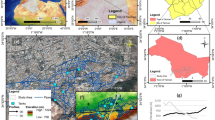Abstract
The study aims to study the prevention and control of mine water inrush and the evaluation of hydrogeological types, thus realizing the effective treatment of mine water and the effective utilization of resources, and expanding the application of numerical simulation methods and algorithm tools in the mine water inrush problem. Starting from the identification of mine water source, first was the use of Fisher discrimination combined with the improved Dijkstra’s algorithm and propose the shortest distance identification principle and the best way to avoid danger. Second, through establishing the numerical model of the fluid-structure coupling, the mechanism of the mine fault water inrush was discussed, and the hydrogeological type of the fault was analyzed. Third, the karst water numerical model was established for achieving the prediction of the amount of the karst water in the period of the mine water inrush. The results showed that Fisher discrimination had high accuracy and good applicability in the identification of water inrush source, and the shortest path calculated by improved Dijkstra’s algorithm is scientific. The evolution of water flow in the disturbed area of fault zone had experienced the process from pore flow to fracture flow and then to pipeline flow. The relative root mean square error (RRMSE) in the application and evaluation of the karst water numerical model is less than 10%. In a word, the fitting effect of the numerical model is good, which can be used in the prediction of mine drainage.




Similar content being viewed by others
References
Carranza F, Romero R, Mazuelos A, Iglesias N (2016) Recovery of Zn from acid mine water and electric arc furnace dust in an integrated process. J Environ Manag 165:175–183
Chang J, Su B, Malekian R et al (2019) Detection of water-filled mining goaf using mining transient electromagnetic method. IEEE Trans Ind Inf 99:1–1
Cui Z, Sheng Q, Leng X (2016) Effects of a controlling geological discontinuity on the seismic stability of an underground cavern subjected to near-fault ground motions. Bull Eng Geol Environ 77(4):1–18
Dai Q, Peng X, Zhao L et al (2017) Effects of underground pore fissures on soil erosion and sediment yield on karst slopes: soil erosion and sediment on karst slopes. Land Degrad Dev:28
Jiang R, Qiao H, Zhang B et al (2016) Efficient fisher discrimination dictionary learning. Signal Process 128(1):28–39
Li Z, Kolmanovsky IV, Atkins EM et al (2016) Road disturbance estimation and cloud-aided comfort-based route planning. IEEE Trans Cybern 47(11):1–13
Liu XQ, Pei T, Zhou CH et al (2018) A systems dynamic model of a coal-based city with multiple adaptive scenarios: a case study of Ordos, China. Sci China Earth Sci 61(3):1–15
Moreno V, Bach J, Zarroca M, Font L, Roqué C, Linares R (2018) Characterization of radon levels in soil and groundwater in the North Maladeta Fault area (Central Pyrenees) and their effects on indoor radon concentration in a thermal spa. J Environ Radioact 189:1–13
Ndlovu M, Demlie M (2016) Hydrogeological characterization of the Kosi Bay Lakes system, North-Eastern South Africa. Environ Earth Sci 75(19):1334
Pérouse E, Sébrier M, Braucher R et al (2016) Transition from collision to subduction in Western Greece: the Katouna–Stamna active fault system and regional kinematics. Int J Earth Sci 106(3):1–23
Qi Y, Li M, Li K, Yeh TCJ (2017) Spatiotemporal development of mine water inrush and its mechanism—a case study in Ganhe coal mine, Shanxi, China. Arabian Journal of Geosciences 10(19):433
Qin L, Ben-Zion Y, Qiu H, Share PE, Ross ZE, Vernon FL (2018) Internal structure of the San Jacinto fault zone in the trifurcation area southeast of Anza, California, from data of dense seismic arrays. Geophys J Int 213(1):98–114
Zhao D, Wu Q, Cui F, Xu H, Zeng Y, Cao Y, du Y (2018) Using random forest for the risk assessment of coal-floor water inrush in Panjiayao Coal Mine, northern China. Hydrogeol J 26(7):2327–2340
Author information
Authors and Affiliations
Corresponding author
Additional information
This article is part of the Topical Collection on Geological Modeling and Geospatial Data Analysis
Rights and permissions
About this article
Cite this article
Chen, J., Li, F. & Lian, Z. The hydrogeology of mine water inrush period using Dijkstra’s algorithm. Arab J Geosci 13, 825 (2020). https://doi.org/10.1007/s12517-020-05846-1
Received:
Accepted:
Published:
DOI: https://doi.org/10.1007/s12517-020-05846-1




